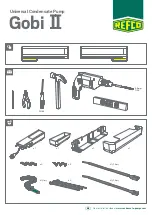
EN
6
Toshiba 1108651075 (EN)
80
210 mm
165 mm
43 mm
In case of bottom right or bottom left piping
•
After scribing slits of the
front panel with a knife or
a making-off pin, cut them
with a pair of nippers or
an equivalent tool.
Slit
In case of left piping
•
After scribing slits of the
front panel with a knife or
a making-off pin, cut them
with a pair of nippers or
an equivalent tool.
Slit
Left-hand connection with piping
Bend the connecting pipe so that it is laid within 43 mm above the
wall surface. If the connecting pipe is laid exceeding 43 mm above
the wall surface, the indoor unit may unstably be set on the wall.
When bending the connecting pipe, make sure to use a spring
bender so as not to crush the pipe.
Bend the connecting pipe within a radius of 30 mm.
To connect the pipe after installation of the unit (figure)
CAUTION
•
Bind the auxiliary pipes (two) and connecting cable with
facing tape tightly. In case of leftward piping and rear-leftward
piping, bind the auxiliary pipes (two) only with facing tape.
•
Carefully arrange pipes so that any pipe does not stick out of
the rear plate of the indoor unit.
•
Carefully connect the auxiliary pipes and connecting pipes to
one another and cut off the insulating tape wound on the
connecting pipe to avoid double-taping at the joint; moreover,
seal the joint with the vinyl tape, etc.
•
Since dewing results in a machine trouble, make sure to
insulate both connecting pipes. (Use polyethylene foam as
insulating material.)
•
When bending a pipe, carefully do it, not to crush it.
NOTE
If the pipe is bent incorrectly, the indoor unit may unstably be set on
the wall.
After passing the connecting pipe through the pipe hole, connect
the connecting pipes to the auxiliary pipes and wrap the facing tape
around them.
Indoor Unit Fixing
1. Pass the pipe through the hole in the wall and hook the indoor
unit on the installation plate at the upper hook.
2. Swing the indoor unit to right and left to confirm that it is firmly
hooked up on the installation plate.
3. While pressing the indoor unit onto the wall, hook it at the lower
part on the installation plate. Pull the indoor unit toward you to
confirm that it is firmly hooked up on the installation plate.
•
For detaching the indoor unit from the installation plate, pull the
indoor unit toward you while pushing its bottom up at the
specified parts.
Press
(unhook)
Push
Push
Hook
Hook here.
1
2
Drainage
1. Run the drain hose sloped downwards.
NOTE
•
The hole should be made at a slight downward slant on the
outdoor side.
2. Put water in the drain pan and make sure that the water is
drained out of doors.
3. When connecting extension drain hose, insulate the connecting
part of extension drain hose with shield pipe.
50 mm
or more
Do not put the
drain hose end
into water.
Do not put the
drain hose end
in the drainage
ditch.
Do not form the
drain hose into
a wavy shape.
Do not rise the
drain hose.
Extension drain hose
Inside the room
Drain hose
Shield pipe
Wall
Drain
guide
CAUTION
Arrange the drain pipe for proper drainage from the unit.
Improper drainage can result in dew-dropping.
This air conditioner has the
structure designed to drain
water collected from dew, which
forms on the back of the indoor
unit, to the drain pan. Therefore,
do not store the power cord and
other parts at a height above
the drain guide.
Space for pipes
1
Installation plate
Auxiliary pipes
Indoor unit
Connecting cable
Installation plate
(To the forefront of flare)
Liquid side
Outward form of indoor unit
R 30 mm (Use polisin (polyethylene)
core or the like for bending pipe.)
Use the handle of screwdriver, etc.
Gas side






































